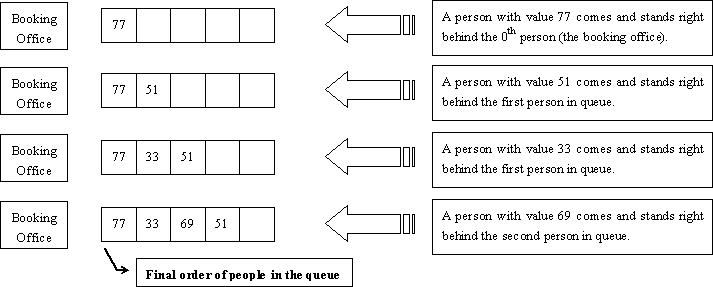poj-2828-Buy Tickets(线段树)
来源:互联网 发布:华为软件下载官方网站 编辑:程序博客网 时间:2024/05/17 23:29
Description
Railway tickets were difficult to buy around the Lunar New Year in China, so we must get up early and join a long queue…
The Lunar New Year was approaching, but unluckily the Little Cat still had schedules going here and there. Now, he had to travel by train to Mianyang, Sichuan Province for the winter camp selection of the national team of Olympiad in Informatics.
It was one o’clock a.m. and dark outside. Chill wind from the northwest did not scare off the people in the queue. The cold night gave the Little Cat a shiver. Why not find a problem to think about? That was none the less better than freezing to death!
People kept jumping the queue. Since it was too dark around, such moves would not be discovered even by the people adjacent to the queue-jumpers. “If every person in the queue is assigned an integral value and all the information about those who have jumped the queue and where they stand after queue-jumping is given, can I find out the final order of people in the queue?” Thought the Little Cat.
Input
There will be several test cases in the input. Each test case consists of N + 1 lines where N (1 ≤ N ≤ 200,000) is given in the first line of the test case. The next N lines contain the pairs of values Posi and Vali in the increasing order of i (1 ≤ i ≤ N). For each i, the ranges and meanings of Posi and Vali are as follows:
Posi ∈ [0, i − 1] — The i-th person came to the queue and stood right behind the Posi-th person in the queue. The booking office was considered the 0th person and the person at the front of the queue was considered the first person in the queue.Vali ∈ [0, 32767] — The i-th person was assigned the value Vali.There no blank lines between test cases. Proceed to the end of input.
Output
For each test cases, output a single line of space-separated integers which are the values of people in the order they stand in the queue.
Sample Input
4
0 77
1 51
1 33
2 69
4
0 20523
1 19243
1 3890
0 31492
Sample Output
77 33 69 51
31492 20523 3890 19243
Hint
The figure below shows how the Little Cat found out the final order of people in the queue described in the first test case of the sample input. 
题意:输入n对数pi, vi,表示在第pi个位置后面插入一个值为vi的人,并且pi是不降的。
并输出最终得到的v的序列。
线段树,记录区间内的空位置数,反过来将人插入到序列中。
#include <iostream> #include <cstdio>#include <cstdlib>#include <cstring>#include <algorithm> #include <vector>#define N 200005#define ll long long#define lson l, m, root<<1#define rson m+1, r, root<<1|1 using namespace std;int tree[N<<2], n, val[N<<2], p[N], v[N];void build(int l, int r, int root){ if (l == r) { tree[root] = 1; return ; } int m = (l+r)>>1; build(lson); build(rson); tree[root] = tree[root<<1]+tree[root<<1|1];}void update(int var, int pos, int l, int r, int root){ if (l == r) { val[l] = var; tree[root] = 0; return ; } /* 若左子树的空格数大于等于要放入的位置,则搜索左子树; 否则,搜索右子树,由于左边有一些空位置,只需要搜索 右子树的部分空位置,使左右空位置之和为要搜索的位置。 */ int m = (l+r)>>1; if (tree[root<<1] >= pos) update(var, pos, lson); else update(var, pos-tree[root<<1], rson); tree[root] = tree[root<<1]+tree[root<<1|1];}int main(){#ifndef ONLINE_JUDGE freopen("1.txt", "r", stdin);#endif int i, j; while(~scanf("%d", &n)) { memset(val, 0, sizeof(val)); memset(tree, 0, sizeof(tree)); build(1, n, 1); for(i = 0; i < n; i++) scanf("%d%d", &p[i], &v[i]); /* 倒过来插入,因为这样插入可以轻易确定所需插入元素的最终位置。 设目前插入元素为x,插入到第k个元素之后,插入的元素的最终位置 就是第k+1个空位置处。 */ for (i = n-1; i >= 0; i--) update(v[i], p[i]+1, 1, n, 1); for (i = 1; i < n; i++) printf("%d ", val[i]); printf("%d\n", val[i]); } return 0;}- poj 2828 Buy Tickets(线段树)
- POJ 2828 Buy Tickets(线段树)
- poj 2828 Buy Tickets(线段树)
- POJ 2828 Buy Tickets(线段树)
- poj 2828 Buy Tickets (线段树)
- POJ 2828--Buy Tickets(线段树)
- POJ 2828 Buy Tickets(线段树)
- POJ 2828 Buy Tickets(线段树)
- POJ 2828 Buy Tickets(线段树)
- POJ 2828 Buy Tickets(线段树)
- POJ - 2828 - Buy Tickets (线段树)
- POJ 2828 Buy Tickets(线段树)
- poj 2828 Buy Tickets(线段树)
- POJ 2828 Buy Tickets(线段树)
- POJ 2828 Buy Tickets(线段树)
- poj-2828-Buy Tickets(线段树)
- poj 2828 Buy Tickets(线段树)
- POJ 2828 Buy Tickets(线段树)
- UsageStatsManager怎样使用问题详解和获取应用使用信息
- 安卓中的Model-View-Presenter模式介绍[Introduction to Model View Presenter on Android]
- windows下gvim隐藏工具栏
- Intersection of Multiple Arrays Sorted Unsorted
- NYoj35 表达式求值
- poj-2828-Buy Tickets(线段树)
- linux重新启动错误 could not update ICEauthority file
- Android中SharedPreferences和序列化结合保存对象数据
- struts2中怎么覆盖默认错误信息以及两种自定义类型转换器的方法
- centos6.6安装pypy
- iOS开发系列—Objective-C之Foundation框架
- 基于VirtualBox安装CoreOS
- 主席树+CDQ分治+整体二分
- Debug和Release版本的区别


